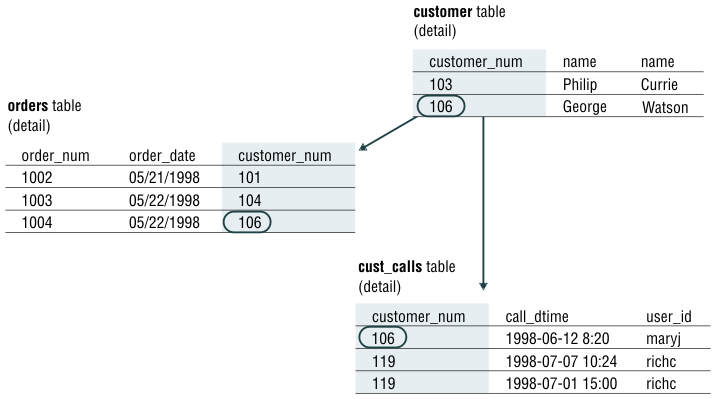
Referential integrity refers to the relationship between tables. Because each table in a database must have a primary key, this primary key can appear in other tables because of its relationship to data within those tables. When a primary key from one table appears in another table, it is called a foreign key.
Foreign keys join tables and establish dependencies between tables. Tables can form a hierarchy of dependencies in such a way that if you change or delete a row in one table, you destroy the meaning of rows in other tables. For example, Figure 353 shows that the customer_num column of the customer table is a primary key for that table and a foreign key in the orders and cust_call tables. Customer number 106, George Watson, is referenced in both the orders and cust_calls tables. If customer 106 is deleted from the customer table, the link between the three tables and this particular customer is destroyed.

When you delete a row that contains a primary key or update it with a different primary key, you destroy the meaning of any rows that contain that value as a foreign key. Referential integrity is the logical dependency of a foreign key on a primary key. The integrity of a row that contains a foreign key depends on the integrity of the row that it references—the row that contains the matching primary key.
By default, the database server does not allow you to violate referential integrity and gives you an error message if you attempt to delete rows from the parent table before you delete rows from the child table. You can, however, use the ON DELETE CASCADE option to cause deletes from a parent table to trip deletes on child tables. See Using the ON DELETE CASCADE Option.
To define primary and foreign keys, and the relationship between them, use the CREATE TABLE and ALTER TABLE statements. For more information on these statements, see the IBM Informix: Guide to SQL Syntax. For information about how to build a data model with primary and foreign keys, see the IBM Informix: Database Design and Implementation Guide.
To maintain referential integrity when you delete rows from a primary key for a table, use the ON DELETE CASCADE option in the REFERENCES clause of the CREATE TABLE and ALTER TABLE statements. This option allows you to delete a row from a parent table and its corresponding rows in matching child tables with a single delete command.
During deletes, locks are held on all qualifying rows of the parent and child tables. When you specify a delete, the delete that is requested from the parent table occurs before any referential actions are performed.
If you have a parent table with two child constraints, one child with cascading deletes specified and one child without cascading deletes, and you attempt to delete a row from the parent table that applies to both child tables, the DELETE statement fails, and no rows are deleted from either the parent or child tables.
You must turn on logging in your current database for cascading deletes to work. Logging and cascading deletes are discussed in Transaction Logging.
Suppose you have two tables with referential integrity rules applied, a parent table, accounts, and a child table, sub_accounts. The following CREATE TABLE statements define the referential constraints:
CREATE TABLE accounts (
acc_num SERIAL primary key,
acc_type INT,
acc_descr CHAR(20));
CREATE TABLE sub_accounts (
sub_acc INTEGER primary key,
ref_num INTEGER REFERENCES accounts (acc_num)
ON DELETE CASCADE,
sub_descr CHAR(20));
The primary key of the accounts table, the acc_num column, uses a SERIAL data type, and the foreign key of the sub_accounts table, the ref_num column, uses an INTEGER data type. Combining the SERIAL data type on the primary key and the INTEGER data type on the foreign key is allowed. Only in this condition can you mix and match data types. The SERIAL data type is an INTEGER, and the database automatically generates the values for the column. All other primary and foreign key combinations must match explicitly. For example, a primary key that is defined as CHAR must match a foreign key that is defined as CHAR.
The definition of the foreign key of the sub_accounts table, the ref_num column, includes the ON DELETE CASCADE option. This option specifies that a delete of any row in the parent table accounts will automatically cause the corresponding rows of the child table sub_accounts to be deleted.
To delete a row from the accounts table that will cascade a delete to the sub_accounts table, you must turn on logging. After logging is turned on, you can delete the account number 2 from both tables, as the following example shows:
DELETE FROM accounts WHERE acc_num = 2
You can use cascading deletes for most deletes, including deletes on self-referencing and cyclic queries. The only exception is correlated subqueries. In correlated subqueries, the subquery (or inner SELECT) is correlated when the value it produces depends on a value produced by the outer SELECT statement that contains it. If you have implemented cascading deletes, you cannot write deletes that use a child table in the correlated subquery. You receive an error when you attempt to delete from a correlated subquery.